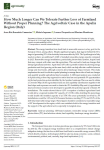Cammerino A.R., Ingaramo M., Piacquadio L., Monteleone M. (2025). How much longer can we tolerate further loss of farmland without proper planning? The agrivoltaic case in the Apulia Region (Italy). Agronomy, 01/05/2025, vol. 15, n. 5, p.1177.
https://doi.org/10.3390/agronomy15051177
https://doi.org/10.3390/agronomy15051177
| Titre : | How much longer can we tolerate further loss of farmland without proper planning? The agrivoltaic case in the Apulia Region (Italy) (2025) |
| Auteurs : | A.R. Cammerino ; M. Ingaramo ; L. Piacquadio ; M. Monteleone |
| Type de document : | Article |
| Dans : | Agronomy (vol. 15, n. 5, May 2025) |
| Article en page(s) : | p.1177 |
| Langues : | Anglais |
| Langues du résumé : | Anglais |
| Catégories : |
Catégories principales 16 - TRANSPORT. INFRASTRUCTURE. ENERGIE ; 16.3 - EnergieThésaurus IAMM ENERGIE RENOUVELABLE ; ENERGIE SOLAIRE ; GESTION FONCIERE ; UTILISATION DES TERRES ; TERRE AGRICOLE ; ITALIE |
| Mots-clés: | AGRIVOLTAISME |
| Résumé : | The energy transition from fossil fuels to renewable sources is a key goal for the European Union, among others. Despite significant progress, Italy lags far behind the EU's target of generating 55% of its electricity from renewables by 2030. The Apulia region in Italy needs to achieve an additional 7.4 GW of installed renewable energy capacity compared to 2021. Renewable energy installations, particularly photovoltaic systems, require land that may compete with other uses like agriculture. This can lead to land-use changes that disrupt agricultural activities. Agrivoltaics (AV) offer a possible solution by allowing energy production and food growing on the same land, which can help alleviate conflicts between energy and food needs, although concerns about landscape impact remain. This study emphasizes the need for effective spatial planning to manage these risks of land use changes and quantify possible agricultural land occupation. A GIS-based analysis was conducted in Apulia using a three-step approach to assess land use and potential AV opportunities: (a) the land protection system identified by the Apulian Landscape Plan was used to obtain a Constraint Map; (b) the agricultural land use and capability classification together with land slope and exposure was used to obtain the AV Availability Map; and (c) agricultural land conversion scenarios were developed to quantify the potential capacity of future AV installations. The results showed that a 0.25% occupation of utilized agricultural land would allow a regional installed AV capacity of 1.3 GW, while doubling this percentage would double the installed capacity to 2.6 GW. The areas potentially involved by AV installations would be 3.25 and 6.50 thousand hectares, reaching 17.5% and 35.0% of the 2030 total renewable energy target. These figures should be considered a reasonable range of AV development in the region, which can contribute both to the energy transition and the support of the agricultural sector, especially in marginal areas. |
| Cote : | En ligne |
| URL / DOI : | https://doi.org/10.3390/agronomy15051177 |







